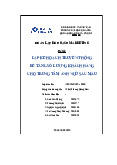



















Preview text:
Lecture 9
Customer Relationship Management (CRM) Objectives
• Identify the primary functions of both customer relationship
management (CRM) and collaborative CRM strategies.
• Describe how businesses might utilize applications of each of
the two major components of operational CRM systems.
• Discuss the benefits of analytical CRM systems to businesses.
• Explain the advantages and disadvantages of mobile CRM
systems, on-demand CRM systems, and open-source CRM systems. • Ref.: Chapter 11
Faculty of Information Technology Introduction to MIS 2
Defining Customer Relationship Management
• In the past, people purchased goods at their neighborhood store
• Today, people purchase goods at the
supermarket, the mall, and the automobile
The customer relationship has become even
more impersonal with the rapid growth of the
Internet and the World Wide Web
Faculty of Information Technology Introduction to MIS 3
• Customer Relationship Management (CRM): is
a customer focused and customer-driven
organizational strategy that concentrates on
assessing customers’ requirements for products
and services and then providing a high-quality,
responsive customer experience.
• Businesses can use information about each
customer to create highly individualized offers
that customers are more likely to accept customer intimacy
Faculty of Information Technology Introduction to MIS 4
• Organizations recognize that customers are the
core of a successful enterprise, and the success
of the enterprise depends on effectively
managing relationships with them
• Modern CRM strategies and systems build
sustainable long-term customer relationships that
create value for the company as well as for the customer
• CRM helps companies acquire new customers
and to retain and expand their relationships with profitable existing customers
Faculty of Information Technology Introduction to MIS 5
• Top 10 Benefits of Adopting a Customer Relationship Management System (CRM)
Source: https://www.naw.org/top-10-benefits-adopting-customer-relationship-management- system-crm/
Faculty of Information Technology Introduction to MIS 6
• 1. Manage customer contact information. Perhaps the most basic of benefits, CRM
helps salespeople create and maintain a database of customer information from basic
information about names and positions, to personal information about business goals,
professional affiliations, and family members.
• 2. Manage sales pipeline or territory results. CRM has the potential to transform a
salesperson from order taker to opportunity manager by reflecting each distributor’s
process for developing opportunities or optimizing a territory and tracking progress across a phased approach.
• 3. Provide access to customer data for salespeople. More than one wholesaler-
distributor admitted that salespeople often wing it when the time comes to visit a
customer, answer a customer question, or solve a customer problem. A more generous
description of this reality is to believe that salespeople act on experience and judgment gained over many years.
• 4. Provide data for coaching by sales managers. From a best-practice perspective,
sales managers should spend at least 50% of their time coaching salespeople.
• 5. Improve handling of leads and prospects. Developing new accounts and finding
new sales opportunities are time-consuming and frequently low-yield processes. When
sales results are going well, lead generating and prospecting are neglected, resulting in
a complete lack of momentum when new business efforts have greater urgency.
Faculty of Information Technology Introduction to MIS 7
• 6. Automate reports for salespeople and management. One of the most immediate
effects of CRM is the ability to create up-to-date dashboards and reports that are both standard and customizable.
• 7. Provide data for management decisions. Sooner or later, experienced users of
CRM live by two rules: (1) no decisions can be made without real and current data and
(2) only data that comes from CRM can be used for decision making. Combined, these
two dictates can have a profound effect on decisions made by an organization’s
leaders. Customer priorities are up front and center.
• 8. Execute marketing programs through salespeople. More and more, executives
told us they are working to achieve a healthy collaboration between marketing and
sales. New levels of internal collaboration are becoming a priority for building a high- performing sales organization.
• 9. Optimize product mix sold to customers. On the margin, the primary tools for
influencing discretionary sales efforts are sales incentives and marketing programs,
including advertising. Incentives work because salespeople are naturally achievement-
oriented, and compensation is the ultimate measure of success.
• 10. Improve accuracy of sales forecasts. One of my favorite quotes, attributable to
Laurence J. Peter, formulator of the Peter Principle, is, “If you don’t know where you
are going, you will probably end up somewhere else.” In the street vernacular of sales
planning, a similar outcome is described by “garbage in, garbage out.” p g, y g g , g g
Faculty of Information Technology Introduction to MIS 8
Faculty of Information Technology Introduction to MIS 9
• Customer Touch Points: is any interaction
between a customer and an organization
Faculty of Information Technology Introduction to MIS 10




